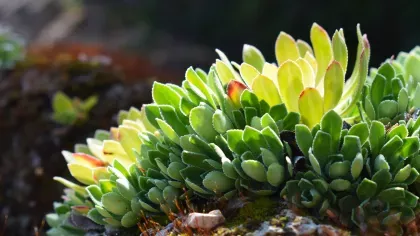16 May 2025
5 min read
Titans, mandrakes and morels: Botanical art from Kew's collections
Explore some unique historical botanical illustrations from Kew's Library and Illustrations collections in celebration of Worldwide Day of Botanical Art.

18 May marks the second Worldwide Day of Botanical Art which looks to celebrate this critical art form and highlight its continued importance to scientific research.
At Kew, our Library and Archives collections contain over 200,000 prints and drawings, assembled over the last 200 years, including wonderful examples of botanical art from across the world.
Here, we showcase some of the incredible botanical and mycological artwork from the Rare Books and Illustrations Collections.
Matilda Smith: Artist
At only 23 years of age, Matilda Smith was a talented artist but had no background in botany.
That didn't stop her being invited by her second cousin, and Director of Kew Gardens, Joseph Dalton Hooker to produce illustrations for Curtis’s Botanical Magazine.
But under his tutelage of her cousin, her understanding of plant anatomy rapidly flourished. She went on to work at Kew for the next 45 years as the Civil Service’s first salaried Botanical Artist and produced over 2,300 drawings for the magazine alone.


A native of the Sumatran rainforest, the titan arum (Amorphophallus titanium) is known in Indonesia as the ‘corpse flower’, thanks to its intense odour often compared to rotting meat.
When it bloomed at Kew in 1898, Smith documented the event for the magazine. And certainly, no-one could accuse her of not suffering for her art.
Hooker recounted that the plant’s unpleasant smell attracted “many blue-bottle flies” and expressed his “deep obligation” to Miss Smith:
“…the talented artist of this work… who in her efforts to do justice by her pencil to these plants, suffered in each case a prolonged martyrdom that terminated in illness.”
Hooker, J.D. (1891), Curtis’s Botanical Magazine, volume 117, tab 7153

Illustrating orchids
Found in almost every part of the world, there are over 30,000 scientifically named species of orchids. With such a wide array of sizes, shapes and colours, it’s no wonder that these plants became hot commodities amongst plant collectors.
During the 19th century, a craze for exotic orchids grew in Europe and orchid collectors became obsessed with acquiring the most beautiful and extraordinary blooms. This craze has left us with a wealth of detailed botanical artwork.
The only son of a landowning family, James Bateman (1811 – 1897) was a ‘gentleman-amateur-botanist’. Thanks to his wealth and facilities, he was able to become a skilled horticulturalist who could grow a range of orchids and bring them to flower.
He published three lavish books about orchids, including "The Orchidaceae of Mexico and Guatemala", which was completed in 1843. One of the largest botanical books ever published at 70 by 53cm, each of its 40 plates cost £200 to produce and only 125 copies were published.


Sarah Anne Drake (1803-1857) was one of the main artists for the publication, contributing 16 of the 40 plates.
She was famous for her impressive ability to work from dried specimens from the herbarium when live plants were unavailable.
Describing Drake’s illustration of Epidendrum erubescens from “The Orchidaceae of Mexico and Guatemala", Bateman stated
“…cultivators will be disappointed to learn that this superb Epidendrum is at present known only by dried specimens belonging to the Royal Herbarium at Munich. The flowers, although faded, still retain a rosy tint, and when fresh could scarcely have been arrayed in less attractive hues than those in which Miss Drake has ventured to portray them.”
Text accompanying tab. XXXII, Bateman, Jas. (James), The Orchidaceae of Mexico and Guatemala, London, Ridgway, 1837-1843

Elsie Wakefield: Mycologist
Elsie Wakefield arrived at Kew in 1910 as an assistant in the collections of fungi, algae and lichens. In just five short years, she’d already been promoted to Head of Mycology. In 1929, she was elected head of the British Mycological Society.
In 1945, she held the post of Deputy Keeper of the Herbarium. At the time, it was the highest position that any woman had held at Kew Gardens. Safe to say, Wakefield was a pioneering mycologist.
Along with her groundbreaking research, Wakefield was also a skilled illustrator, producing watercolour drawings of the species she identified. Many of her illustrations and publications are held at Kew.

Morel mushrooms come in many sizes: some are as small as a thumbnail, others might be as big as your hand.
But they all share the distinctive honeycomb outer surface that Wakefield describes in her description of this species, Morchella esculenta.
Wakefield, recognising the morel’s value as an edible fungus, has even provided a couple of suggestions as to how this mushroom might be served - “stewed with gravy, or stuffed with minced meat and crumbs and baked”.

Mandrakes and myths
The oldest printed book in Kew’s Library dates from the 1480s, and features incredible and fantastical botanical illustrations.
Ortus Sanitatis, literally “Garden of Health” was printed by Peter Schoffer in Mainz, Germany. The illustrations are woodblock prints, that were then hand coloured.
The unknown illustrator may not have seen a real mandrake and was most likely copying an earlier illustration. This was more common in a time before our modern approach of illustrating plants based on observations.


A member of the Solanaceae family that includes potatoes and tomatoes, there are many myths and legends surrounding the mandrake.
We now know that the roots, leaves and fruit contain hallucinogenic substances. Mandrake was traditionally used as an aphrodisiac, an emetic, an antidepressant, a sedative and an analgesic. It is also toxic, and could be used as a poison.
Often used as an amulet, the mandrake was believed to make women fertile, presumably associated to its shape.
It was also believed that when picked, it would emit a scream and anyone hearing it would die an agonising death. It was said to harvest the plant safely, the leaves would be tied to a dog that would then pull up the root from the earth.






